This guide focuses on the publication settings for Amazon, so it only explains how to fill in the sections available for this specific sales channel.
If you want guidance on all sections of the publication settings, including those not available for Amazon, read the guide How to publish a catalogue.
N.B.: Before you can publish on Amazon, you must:
- configure your seller account in SellRapido. If you have not configured it yet, click here to find out how.
- disable the creation of international offers. Click here to find out how to proceed.
Contents
Introduction
Publishing a catalogue on marketplaces or e-commerce sites involves two key steps:
1. Applying the publication settings
In this process, the key elements for the publication of products are defined: prices and mark-ups, shipping costs, payment methods and much more.
2. Applying the include and exclude filters
In this phase you must finalise the publication, by setting include and exclude filters in the Filters tab to establish which products to publish and which to exclude from publication
Below we see in detail how to apply the settings and how to finalise the publication of a catalogue on Amazon.
Publication settings
Defining publication settings is the first step towards publishing a catalogue.
To apply the publication settings, follow these steps:
1. Got to Pre-sales > Products, select the catalogue to be published, click on ![]() Settings and then on New.
Settings and then on New.
Indicate the sales channel you would like to publish on; in this case:
- Marketplace: Amazon
- Credential: the already configured credential appears. If you have configured more than one credential, choose the one you want to use
- Channel: select the country in which you want to publish
Click on OK.
 |
A row will be created with the sales channel attached. The status will initially be red; you need to apply the publication settings for it to turn green.
 |
2. Click on the dial.
A window will open showing the settings to be applied in order to publish the products on Amazon. ![]()
Let us see in detail how the publication settings work.
General rules vs specific rules
Before defining the settings, it is essential to understand how the various tabs to be filled in are built, and, in particular, what the difference is between general and specific rules.
- General rules: these are set at the top of each tab. They are rules that apply to all products you publish on any given sales channel.
- Specific rules: these are set at the bottom of each tab. They are applied only to products that fall within the parameters you have specified.
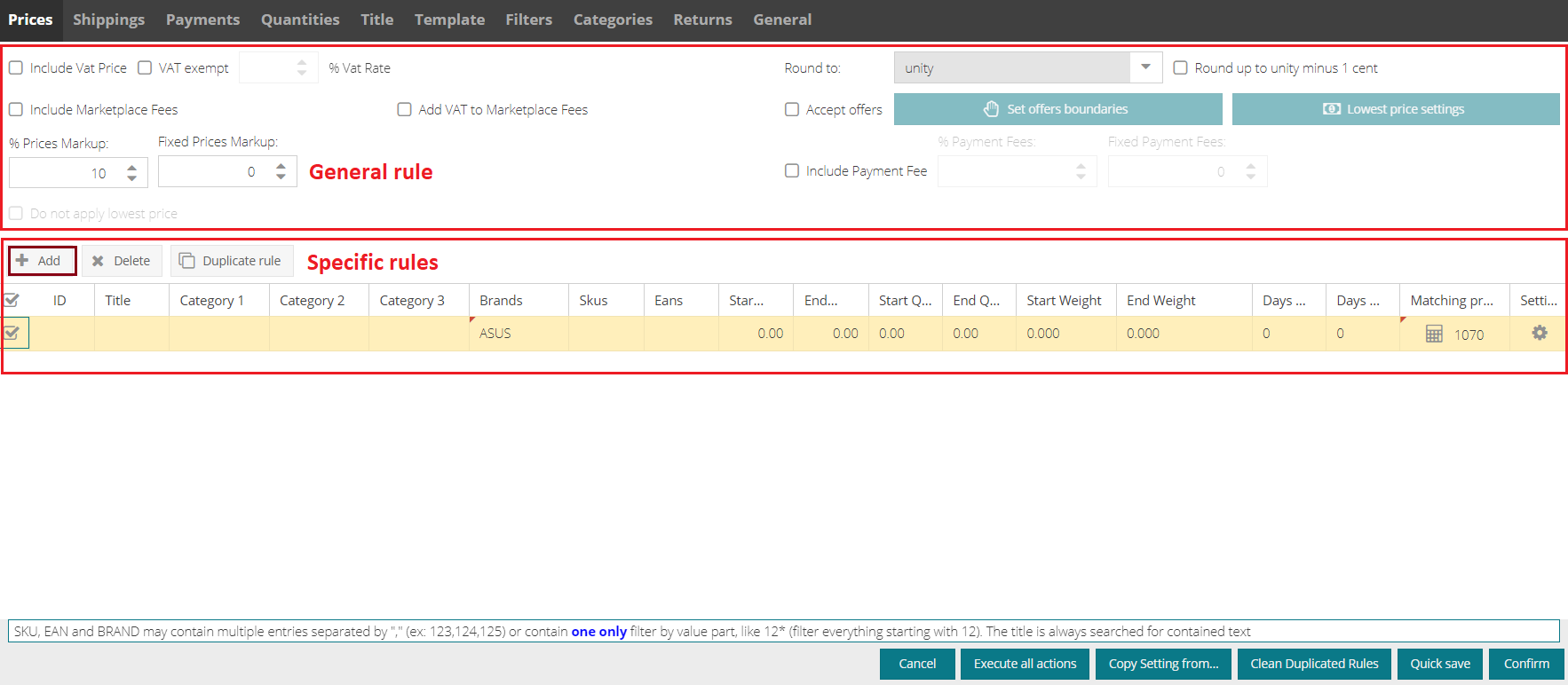 |
To set a specific rule:
1. Click on the New button. A row is created, indicating the products to which the rule will be applied.

The products to which the rule is to be applied can be filtered using the following parameters:
- Category 1/2/3
- Brand
- Individual or Groups of SKU
- Individual or Groups of EANS
- Price ranges
- Weight ranges
- Order preparation day ranges
This will open a window where you can set the rule that will be applied to products falling within the parameters of that row.
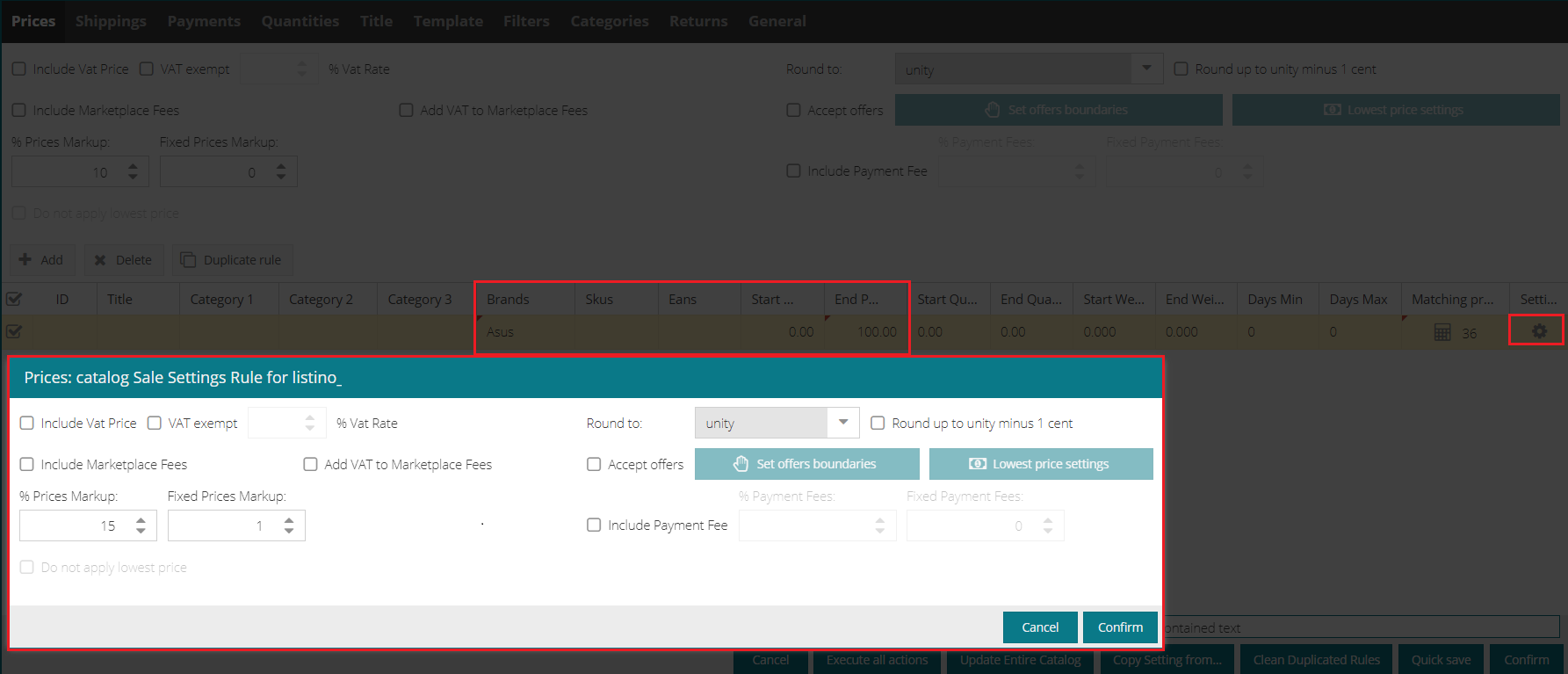
Example: a 15% mark-up and fixed mark-up of € 1 will be applied to all Asus brand products between € 0 and € 100.
If one or more products fall within the parameters of multiple rows, the applicable rule will always be that of the highest row.
Drag upwards or downwards to change the order of the rules.
How to fill in publication settings tabs
Once you understand how general rules and specific rules work, you can go on to define the settings.
Bear in mind that the fields to be set may vary depending on the marketplace: when a section is not editable, it means that it cannot be managed for that specific marketplace(in this case Amazon).
Let us see in detail how to fill in each section:
Prices
In this tab, you can manage various settings related to the price of the products to be published.
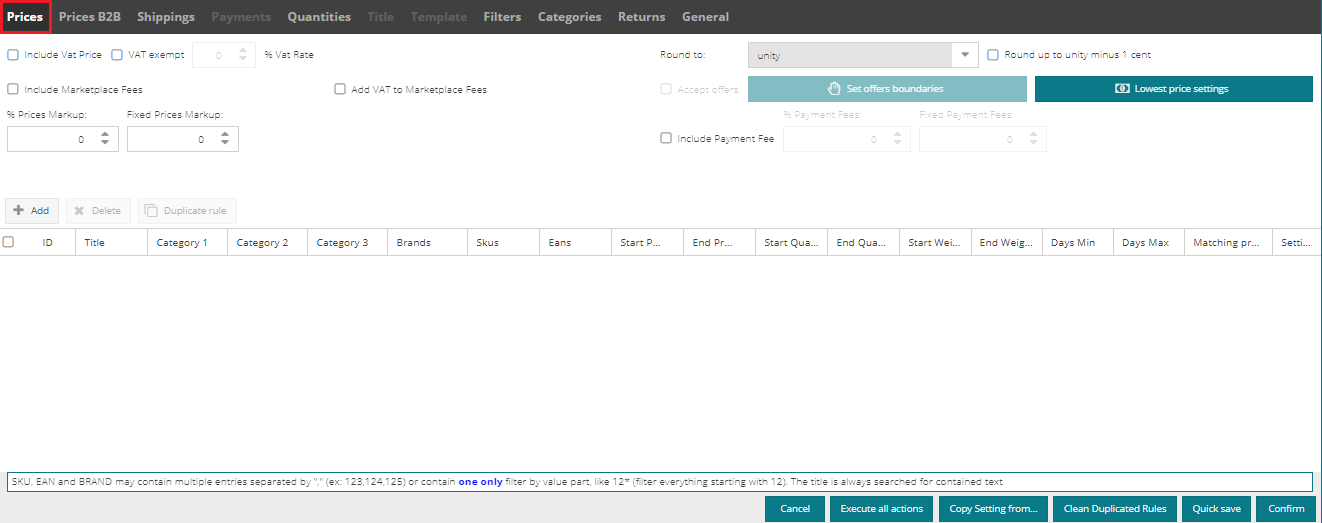 |
The fields to be filled in and the options that can be enabled in this tab are listed below:
1. Adding VAT to the price
To add VAT to the price, flag this section and indicate the percentage of VAT (if applicable).
Bear in mind that prices in the upstream listing are generally exclusive of VAT.
But if, upstream in the catalogue, there is a column with a value stating the VAT percentage, do not flag this box: the system will add the VAT to the final price in the catalogue.
2. Adding Marketplace Commissions
This box allows the system to add the commission charged by the marketplace/e-commerce site to the final price based on the product category of each product.
3. Adding VAT to Marketplace commissions.
If this box is ticked, the system will add VAT to the commission charged by the marketplace.
N.B.: If you are registered in the VIES, do not flag this box.
4. Rounding off
You can choose to round the price to the decimal place (e.g. € 11.70) to the unit (e.g. € 12), or to the unit minus one cent (e.g. € 11.99).
For the best chance of winning the BuyBox, we recommend that you flag the rounding off to two decimal places.
You can enter a percentage and/or fixed mark-up to be added to the list price.
To apply a discount, enter a minus sign in front of the mark-up (e.g. “-5.00”).
All calculations are made using the catalogue currency.
At the time of submission, SellRapido converts the amounts to the currency of the target marketplace. For this reason, fixed mark-ups must always be in the currency of the listing.
6. Specific rules
As with any tab, at the bottom of the page you can set specific rules for groups of products that meet certain criteria (go back to the section general rules vs specific rules to recall in detail how to do this).
7. Lowest price settings
This function allows you to automatically raise or lower the price of a product published on Amazon, to ensure that you have the lowest price for that product where possible and to help you obtain the BuyBox more easily.
 |
To apply this setting:
a) Click on Lowest Price settings
b) Flag the Use Lowest Price
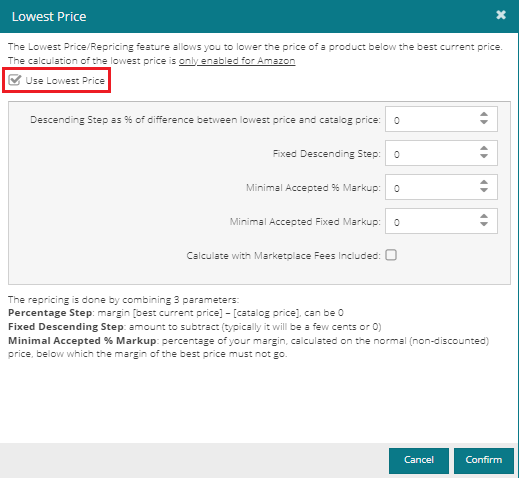 |
c) Define the parameters for repricing (i.e. automatic price change):
- Descending Step as % difference between lowest price and catalog price: how much you want to lower your price (in percent) from the current best price.
- Fixed descending step: how much you want to lower your price (in euros) from the current best price.
- Minimum accepted % Markup: minimum percentage mark-up to be applied at all times, regardless of the decrease scale.
- Minimum accepted fixed markup: minimum fixed mark-up to be applied always, regardless of the decrease scale.
- Calculate with marketplace fees included: SellRapido will also calculate marketplace commission. Always flag this item.
Your price will be adjusted taking into account the minimum mark-up you have set: if it is not possible to get the best price while maintaining the desired minimum mark-up, the price will not be lowered.
We recommend setting the parameters as follows:
- Fixed descending step: 0.05 / 0.10
- Minimum accepted % Markup: 7% (a minimum mark-up of 7% on the initial price will always be applied to this product)
We suggest that you do some simulations to see how the calculation is performed and what the sale price will be.
How the best price works
Publication using the best price takes place as follows:
a) The first time the offer is created, the system calculates the price of the product without using the best price function, which is why it is important to always fill in the “standard” mark-ups section:
b) Shortly after publication
c) At the next best price download, which happens within 1 hour of the latest publication, SellRapido checks whether your price is the lowest on Amazon. If it is, download the second-best price and raise your price so that it is only slightly lower than the second best price.(usually 10 or 20 minutes depending on the number of offers), SellRapido downloads the best price currently available on Amazon and, if your price is higher than this, applies repricing to get a lower price.
This way SellRapido ensures that there is no excessive gap between your price and the second lowest: yours will only be lower by the amount necessary to ensure you offer the best price on the Marketplace.
B2B Prices
To manage the publication of the Business price you have to enable it on the Seller Central, click here to read how to do it.
B2B prices must always be lower than B2C, otherwise the system will return an error in the Ads Report.
1. Click on New to create the B2B pricing rule
 |
The products to which the rule is to be applied can be filtered using the following parameters:
- Category 1/2/3
- Brand
- Individual or Groups of SKU
- Individual or Groups of EANS
- Price ranges
- Weight ranges
- Order preparation day ranges
2. When you have defined the parameters, click on ![]() Settings in the same row.
Settings in the same row.
This will open a window where you can set the rule that will be applied to products falling within the parameters of that row.
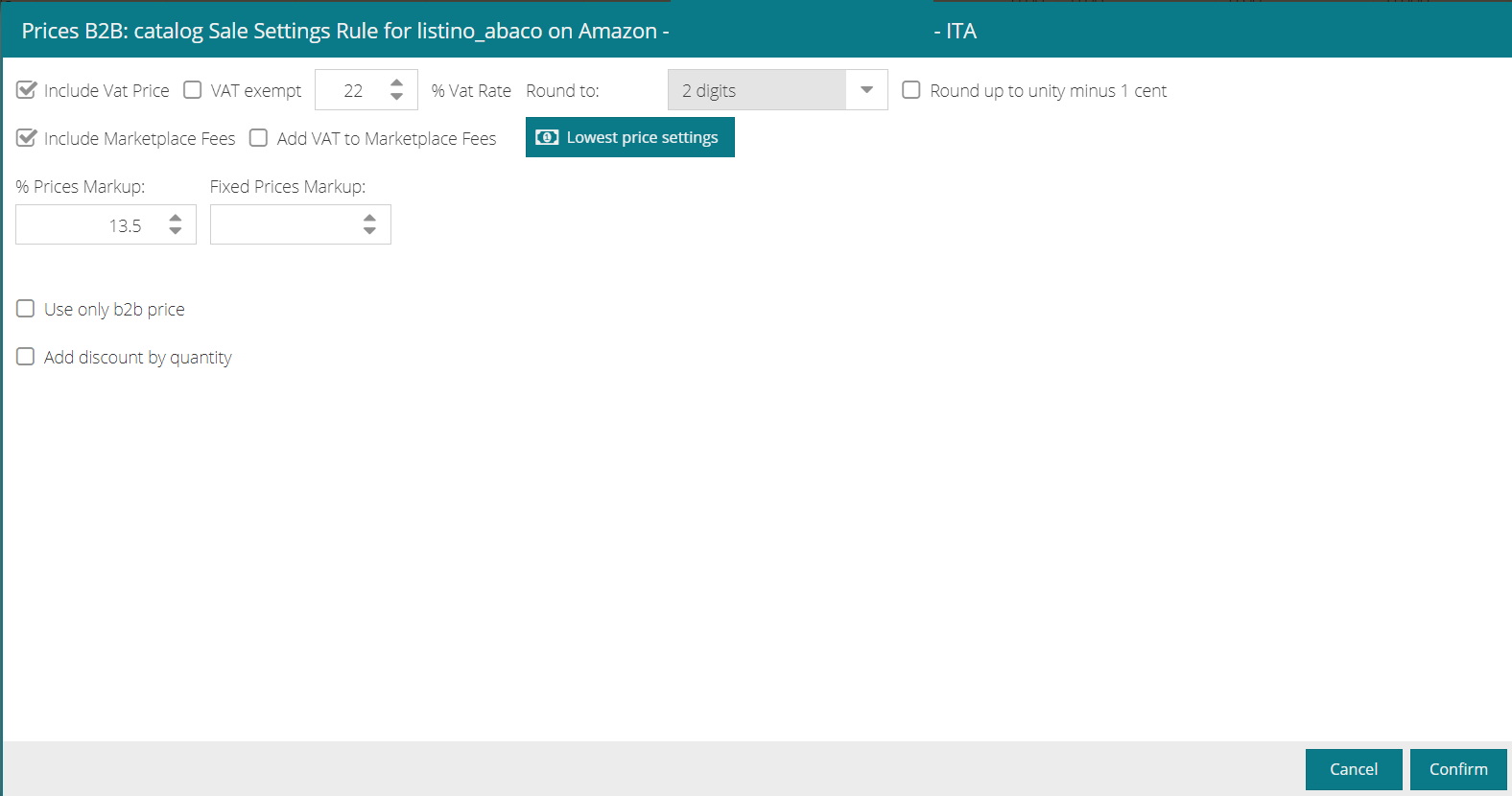 |
- Use only B2B price
Sellrapido will pubblish only the B2B products, if you have the same products in the B2C, these will be excluded.
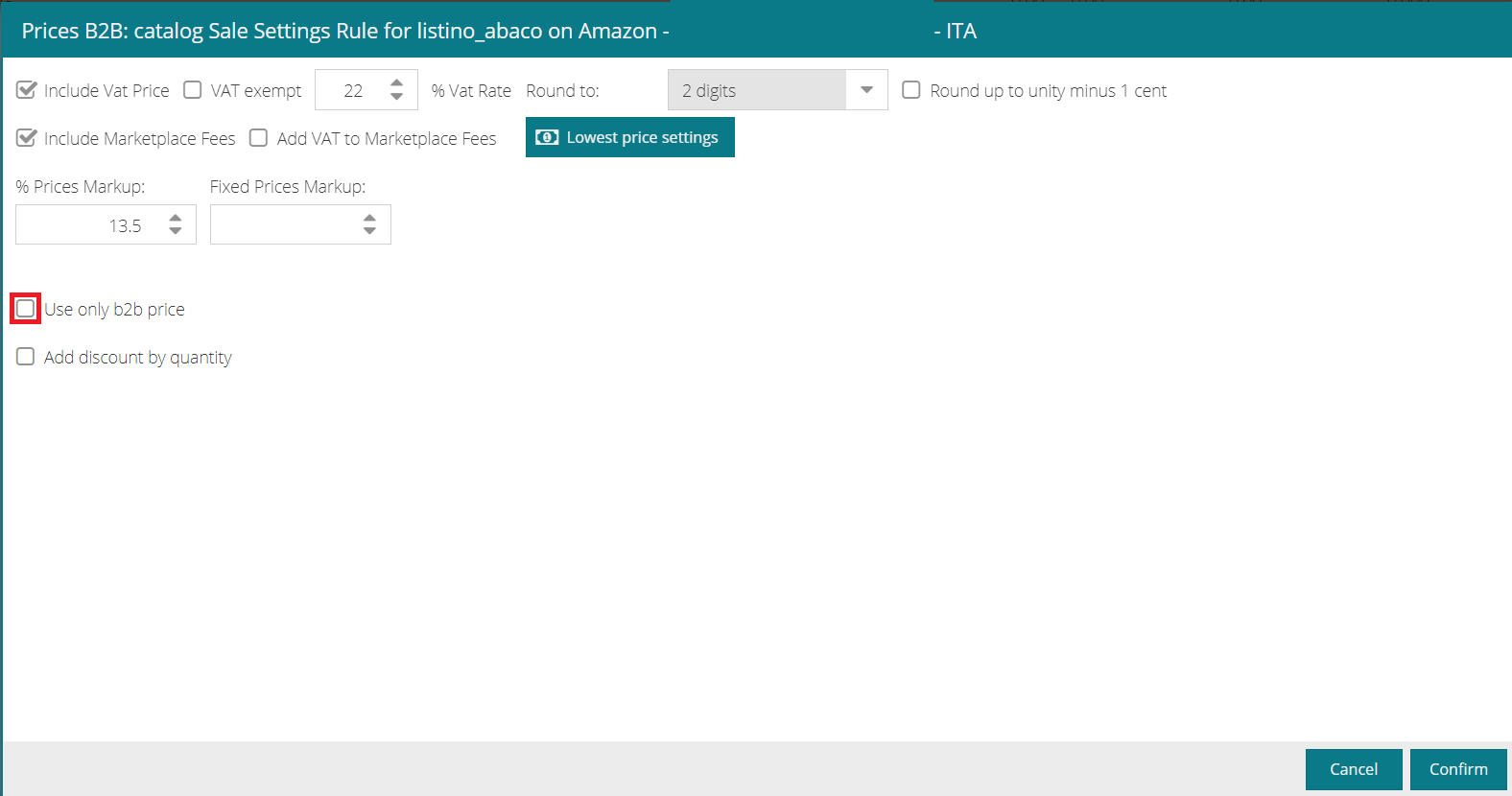 |
-
Add discount by quantityDiscount quantity: click on the drop down menu and choose between:- Discount by percentage: enter the percentage discount, example: 5%
- Discount fixed: enter the fixed discount, example: 5%
Quality lower bound: enter the number of pieces to buy to receive the discount
Discount price %: enter the discount (fixed or percentage)
You can fill five fields from 1 to 5, flag the box to enable the row
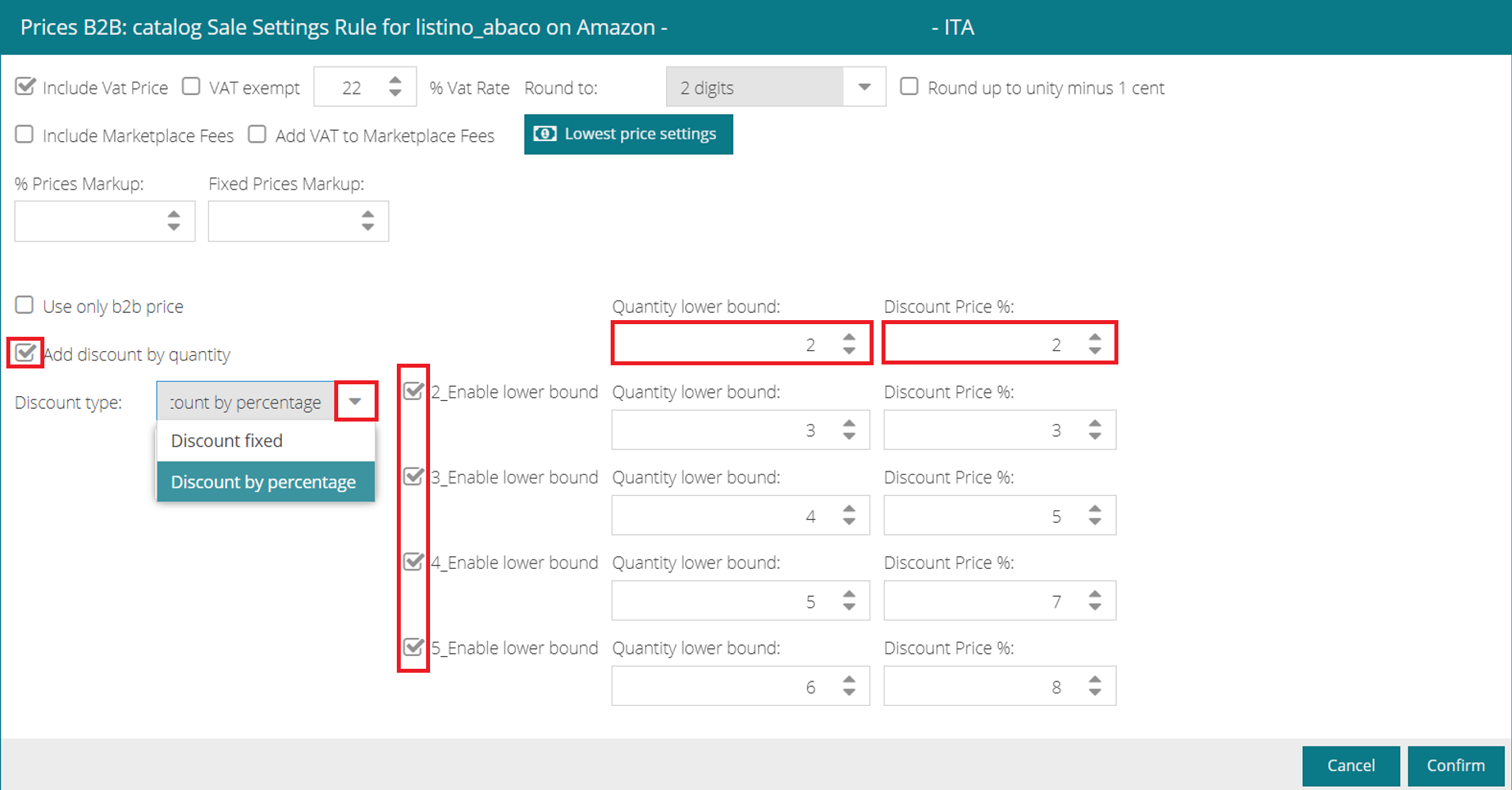 |
N.B. Note that piece and discounts values must always be incremental.
If in the first row you choose Quality lower bound 2 and Percentage discount 2, in the next line you will have to enter larger values for both fields
Alternatively an error will appear.
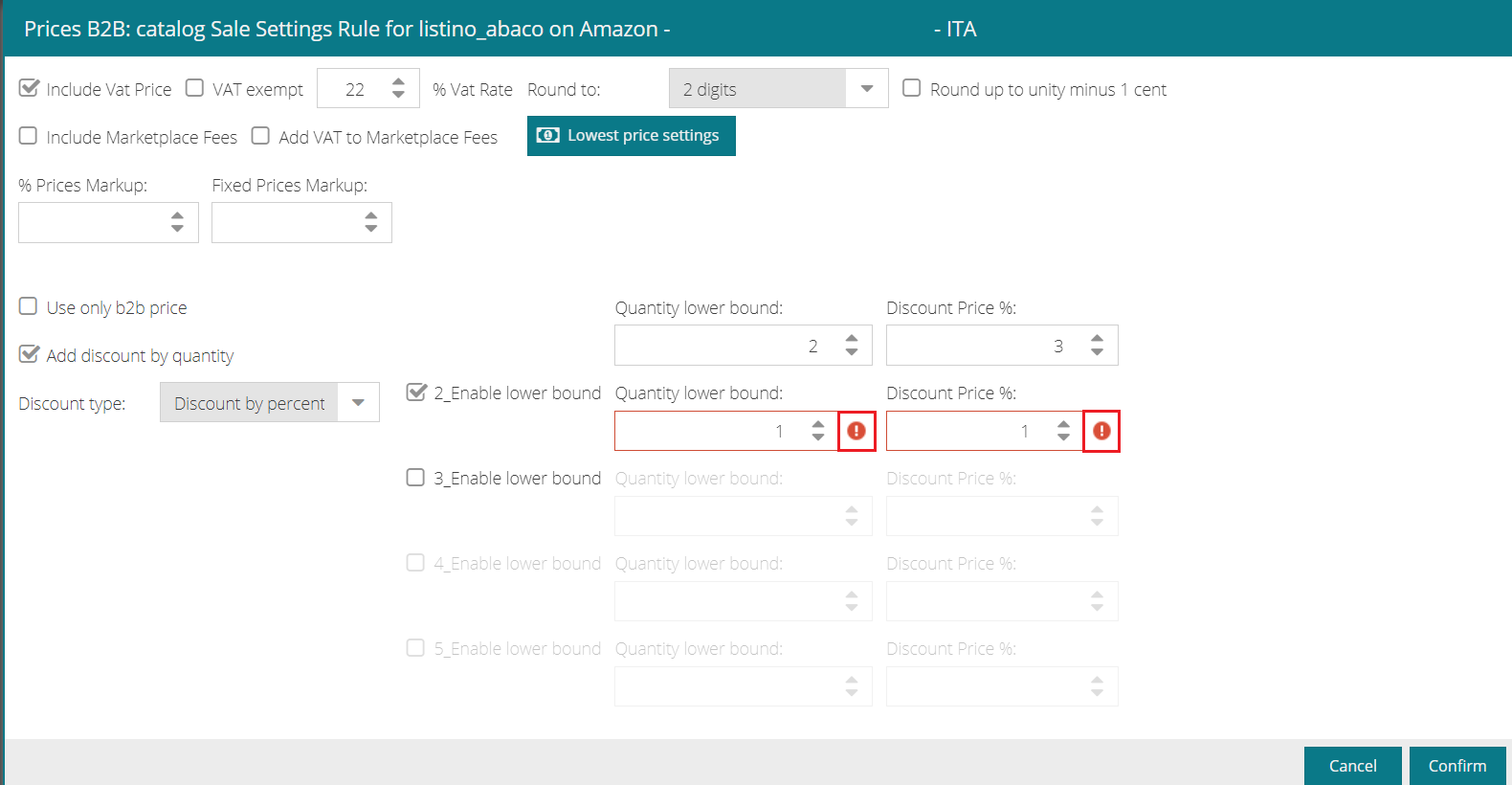 |
Activate the Lowest price settings
Click on Lowest price settings, see here how to use it
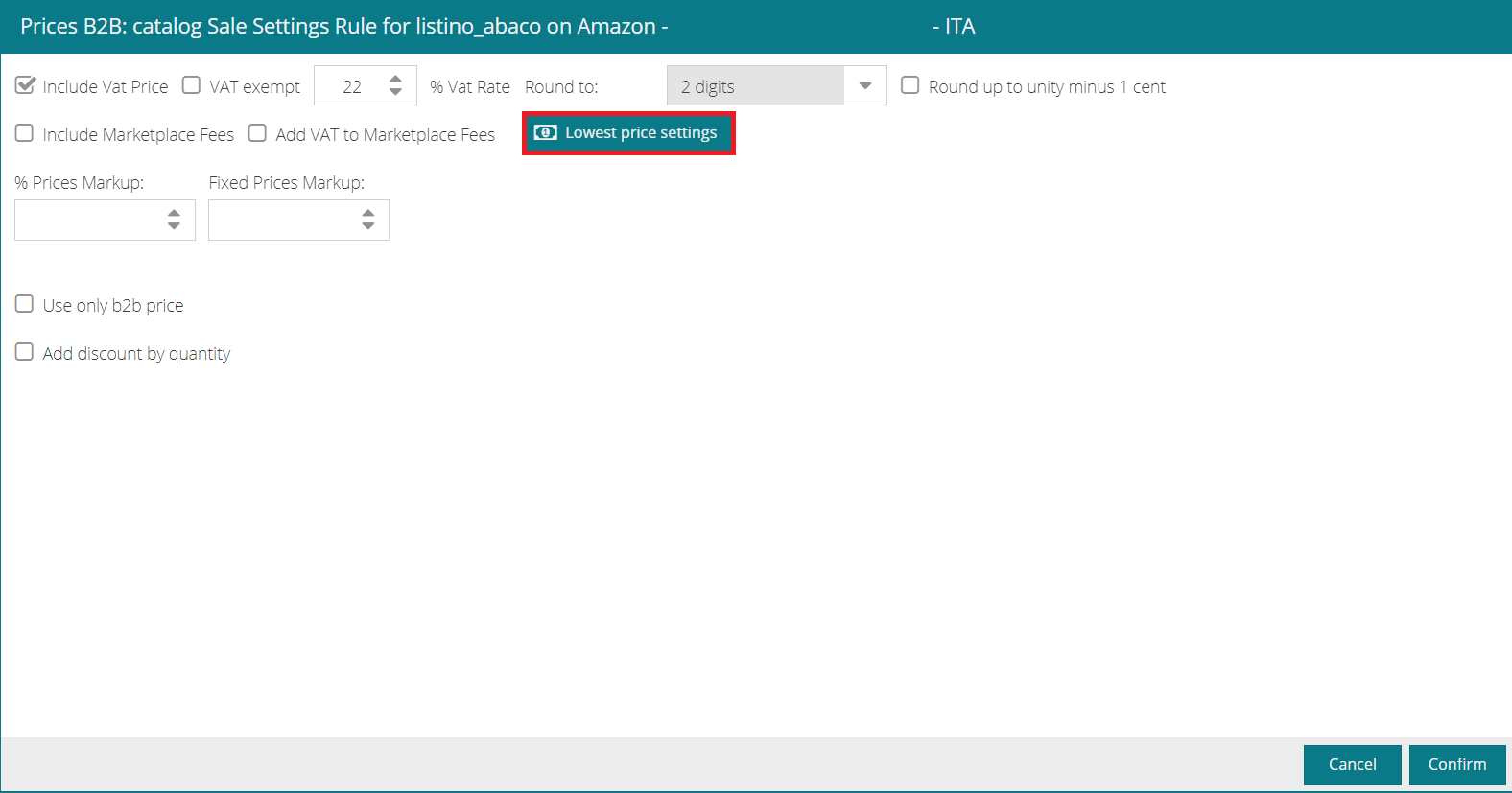 |
Shipping
Amazon does not give the option of choosing the shipping method.
Instead, you can fill in the following fields:
1. Fees
Flag the box Taken from listing if this information is present upstream in the catalogue. If it is not, fill the field with the shipping cost (the cost will always be shifted onto the price)
2. Order preparation times
Flag the box Taken from listing if this information is present upstream in the catalogue, otherwise it indicates the number of days it takes to prepare the order.
The value entered must be greater than or equal to 1 day.
The delivery time you set on Amazon Seller Central in Settings > Shipping settings is added to your order preparation time.
3. VAT inclusive fee
If the shipping cost entered in the Fees field is exclusive of VAT, flag the Vat inclusive fee option and enter the percentage of VAT to be applied.
4. Setting sales rules
This option allows you to set on SellRapido a previously configured Amazon shipping rule.
This will disable the rest of the settings and the system will publish using the rules “copied” from the marketplace.
 |
To set up a rule previously configured on Amazon, click on Set Marketplace rules and enter the exact name used for the Amazon rule.
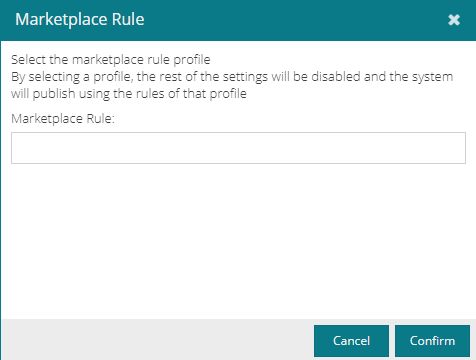 |
This rule can only be used for products with an ASIN.
If there is no ASIN, SellRapido will perform an initial upload with the normal settings, i.e. without using the shipping rule.
Once downloaded, the ASIN associated with the offer will make subsequent uploads using the shipping rule that has been set.
The order preparation days are still sent together with the sales rule; they should always be specified.
After inserting a Marketplace rule, go back to the Amazon default shipping template by writing the default template name (as it appears on Amazon) in “Marketplace rule”.
It is therefore not enough to simply remove the shipping rule.
Quantities
On this tab you can set the quantity of products that will appear in the ad.
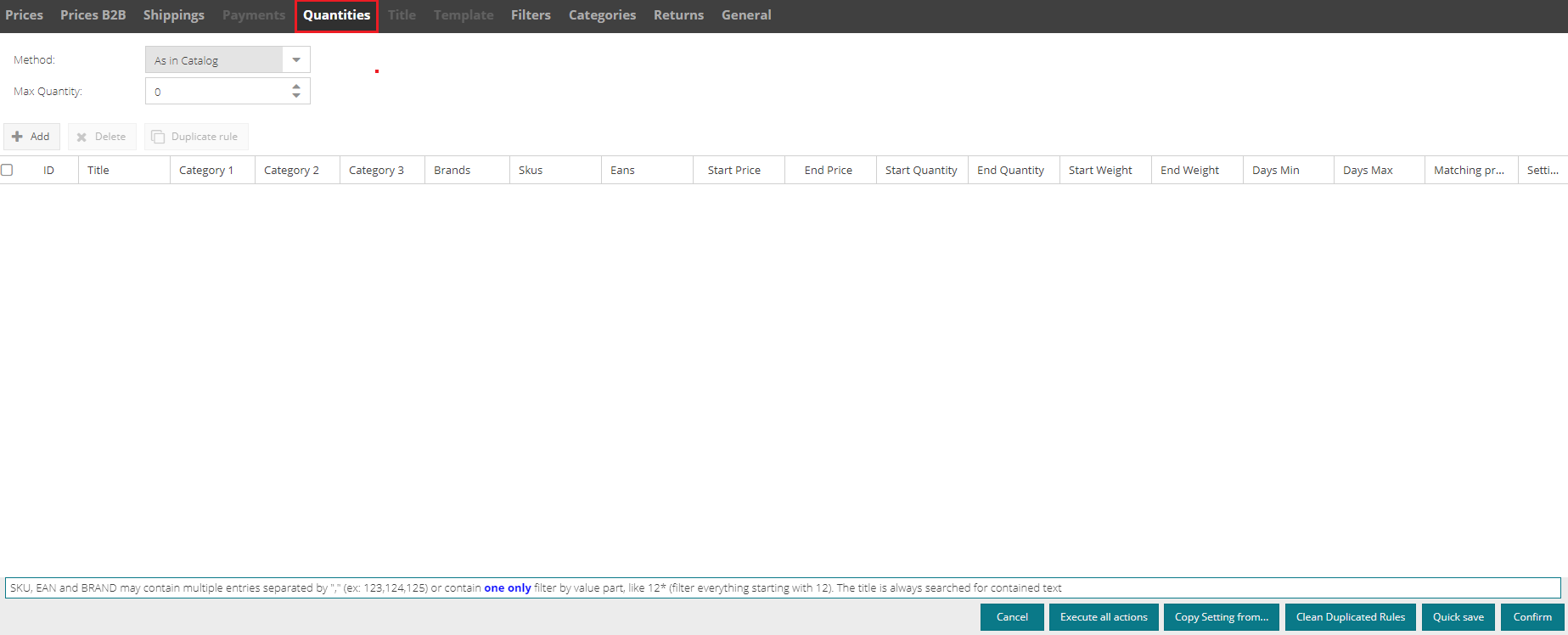 |
There are 3 ways to manage this data (selectable from the Method drop-down list ):
- import the quantities from the listing
- set a fixed quantity by entering in the field the number of pieces to be displayed
- setting a random quantity to publish a random quantity within the range of the two numbers entered in the two boxes.
You also have the option to set a maximum quantity of pieces to be displayed in the ad.
Filters
In this tab you can finalise publication on the sales channel by setting filters to include or exclude certain products from publication.
To see in detail how to do this, go to the section Publishing the catalogue.
Categories
In this tab you must associate Categories 1/2/3 (i.e. those in the upstream listing) with the Channel Category (i.e. the category in use for the sales channel on which you are publishing). The latter allows SellRapido to calculate the commission provided by the marketplace / e-commerce for a given product category.
N.B.: the marketplace commission calculated via the channel category is the one that will be applied when calculating product prices via the Add Marketplace commission button (see step 2 of the Prices section).
Therefore, care must be taken during this step and the channel categories must be set correctly to avoid setting the wrong commission.
To associate the upstream listing categories with the channel category, follow these steps:
1. select one or more rows of categories by flagging the relevant box
2. click on the button ![]()
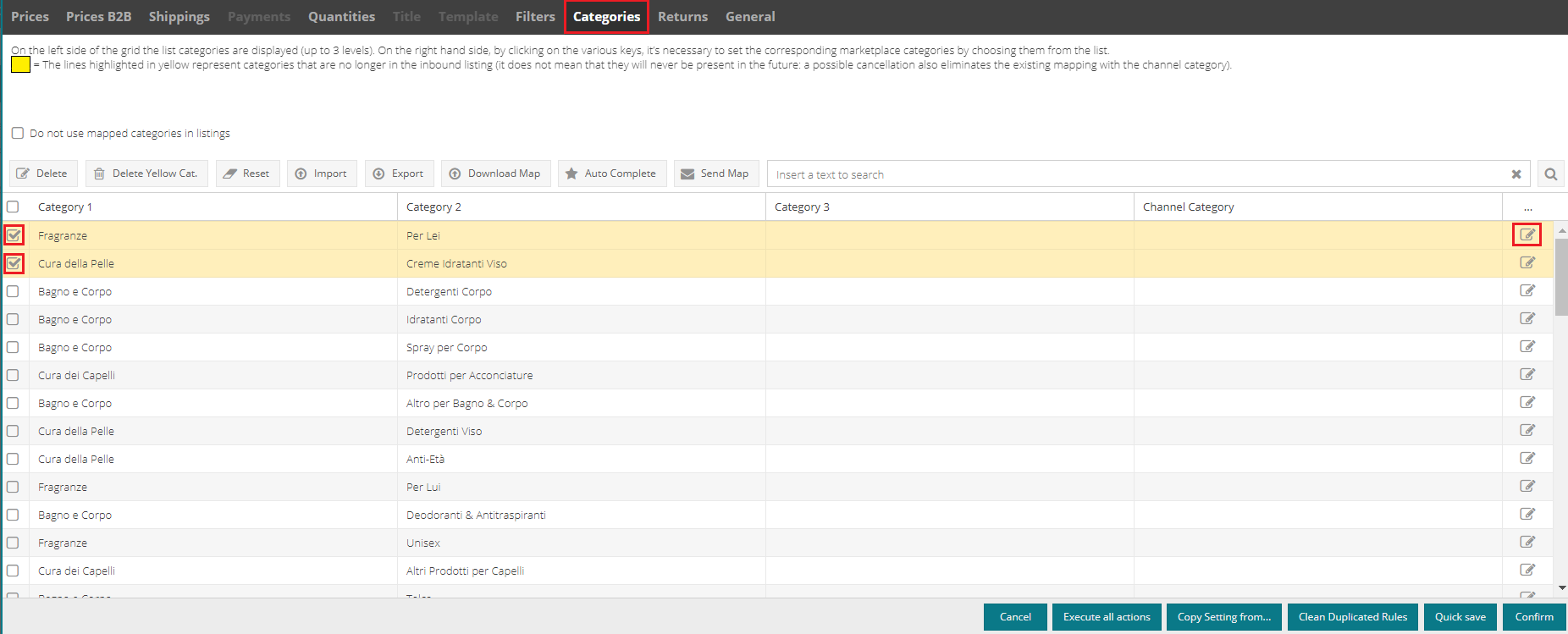 |
3. choose the channel category that best fits categories 1/2/3 and click on the arrow ![]() to set it. on one of the selected rows.
to set it. on one of the selected rows.
 |
If you selected several rows in the previous step, the same channel category will be set for all the rows selected.
4. When set, click on Confirm at the bottom right corner to save.
Returns
In this tab you must indicate the country from which your products are shipped (which will be included in your Amazon offer details).
This information is mandatory for publication on Amazon UK, IT, and US.
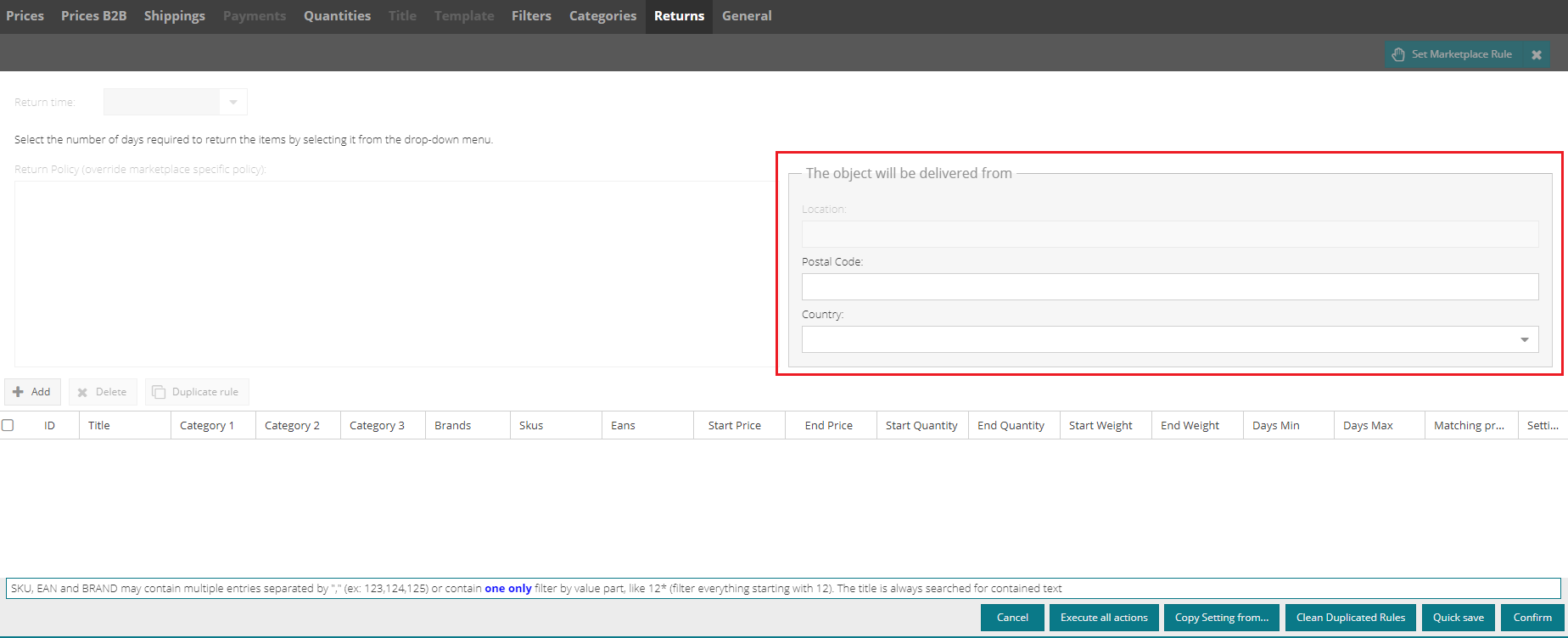 |
General
On this tab, you can flag Maintain relevance to keep an out of stock product ad active.

Publication of the catalogue on a sales channel
As explained in previous sections, a catalogue is published by inserting an include filter.
In the Filters tab, Include or Exclude filters must be set to identify which products to publish and which to exclude from publication.
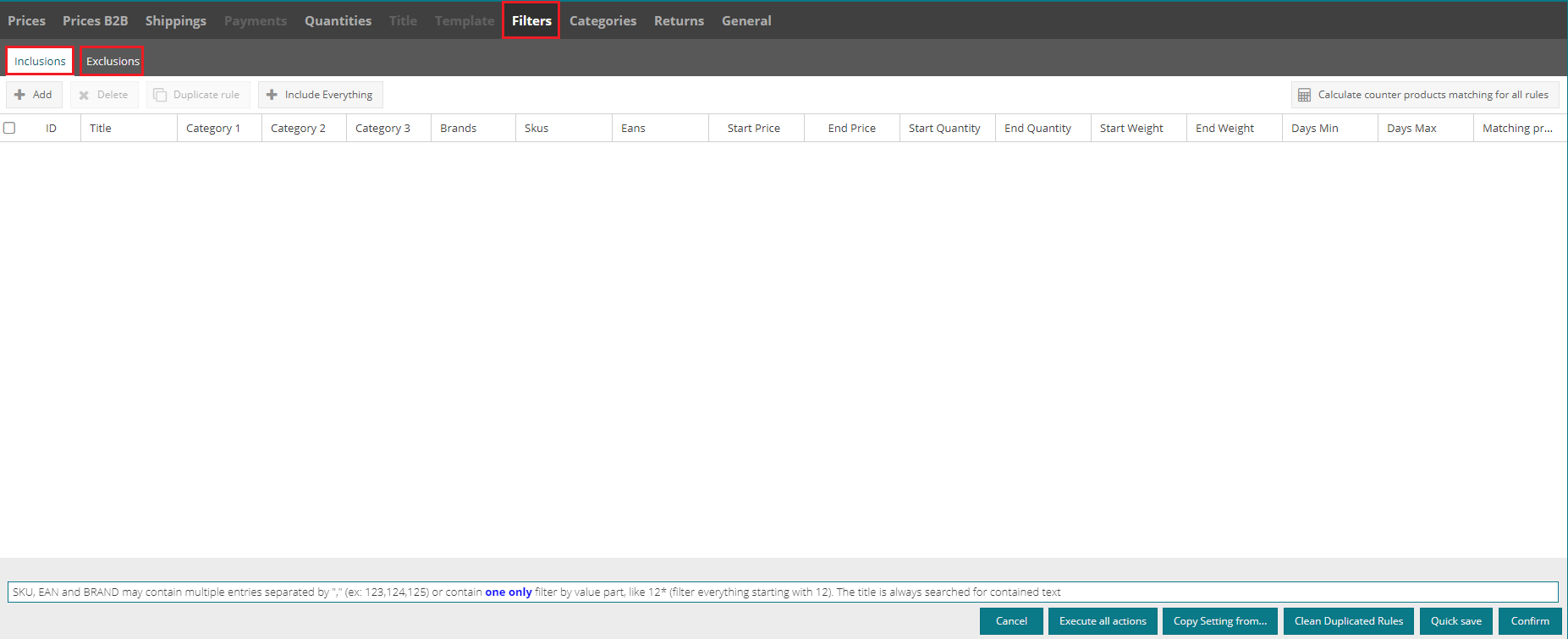 |
Products can be filtered under the following parameters:
- Category 1 / 2 / 3
- Brand
- SKU
- EAN
- Price range
- Min./max. quantity
- Weight range
- Order preparation day ranges
Products on the listing that match the Include rules will be published, while products that match the Exclude rules will not be published.
N.B.:
The insertion of a total inclusion filter is strongly discouraged.
We advise you to publish products at a gradual pace, especially if the marketplace account you are using has just been opened.
To create a new rule, click on Newand set the parameters to filter the products.
Example:
 |
In the example image, all products that meet the following parameters will be published:
- Category 1: Cosmetici
- End Price: 100
- Start Quantity: 20
- Matching products: 905
Under this rule, the system will then publish all products between € 0 and € 100, belonging to the Cosmetici Category 1, and a Start Quantity 20.
In the Corresponding Products column, you can see the quantity of products uploaded on the basis of the filters applied.
Include/exclude by brand
To include or exclude products of different brands, enter their names (including any spaces, e.g. Infinity Light) in the Brands field, separating them with a comma.
N.B.: there should be no spaces before and after a comma.
Example: canon,infinity light,zyxel
Checking the ad reports
After publishing a catalogue, it is essential to monitor the Ad Reports to check the status of publications.
This is a very important step, as it will allow you to detect any errors and make the necessary changes for successful publication of products.
Click here to read the guide on checking your Ad Reports.
-1.png?height=120&name=logo_sellrapido_ottanio%20(1)-1.png)